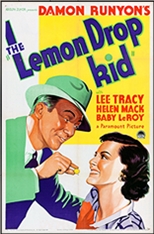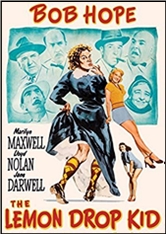Tue 20 Feb 2024
From Page to Screen. by Mike Tooney: DAMON RUNYON “The Lemon Drop Kid” // Films (1934/1951).
Posted by Steve under Films: Comedy/Musicals , Reviews[7] Comments
DAMON RUNYON “The Lemon Drop Kid.”
DAMON RUNYON “The Lemon Drop Kid.” Short story. First appearance: Collier’s, 03 February 1934.
Damon Runyon (1880-1946) used to be a household name. He was famous for two reasons: his reportage, often covering some of the most sensational stories of the first half of the 20th century, and his fiction, featuring thinly disguised real people in occasionally outlandish situations, written in a narrative style uniquely his own.

Nowadays Runyon’s reputation rests almost entirely in his “Broadway stories,” such as Guys and Dolls. People who knew Runyon well claimed his hardboiled exterior concealed a cultured and sensitive interior. In any case, he was friends with the infamous (Al Capone was a neighbor) as well as the famous (in accordance with Runyon’s wishes, Captain Eddie Rickenbacker flew low over Broadway and scattered his ashes over the district).
One of Runyon’s “ironic mini-comedies” involves a racetrack tout named The Lemon Drop Kid. A tout, for the uninitiated, is a hustler who pretends he has inside information on an upcoming race (when, in fact, he has none), and who by getting some sucker to get in on the betting is able to clear a few “bob” for himself, the sucker usually being happy enough to cut the tout in on the winnings — but being very unhappy when the tip doesn’t pay off as advertised.
This is called “telling the tale,” and The Lemon Drop Kid is normally very good at it.
But on this particular occasion, The Kid accidentally misdirects his mark, and through a major misunderstanding takes it on the lam to escape what he mistakenly assumes will be retributive justice in the form of The Kid’s tender flesh.

And so he literally runs away from the racetrack, with his mark in hot pursuit.
Eventually, The Kid will find love for the first time in his life, but the experience will prove bittersweet . . . .
Runyon’s story has been filmed twice, once by Paramount in 1934 with Lee Tracy, Helen Mack, and William Frawley (remember the growly landlord in I Love Lucy?); and a second time by Paramount in 1951 with Bob Hope, Marilyn Maxwell, Lloyd Nolan, Fred Clark, and William Frawley again.
The 1934 version, we are told, adheres more closely to the original story. Those who have seen it say it starts out a comedy and ends up on a more serious note, very much like Runyon’s tale. The claim has been made that Paramount suppressed this film in favor of the remake.
The 1951 edition takes the idea of The Kid misinforming someone about a bet and runs with it; the whole thing is played for as many laughs as possible (e.g., The Kid initiating a scam on little old ladies, Bob Hope in drag; you get the idea).
Hope’s film also introduced a song that became an instant Christmastime standard, “Silver Bells.”
To give you an idea of how much the 1951 movie differed from Runyon’s story, get a load of this list of characters’ names that never appeared in the original tale: Sidney Melbourne, ‘Brainy’ Baxter, Oxford Charley, Nellie Thursday, Moose Moran, Straight Flush, Gloomy Willie, Sam the Surgeon, Little Louie, Singing Solly, The Bird Lady, and Goomba. “Sidney Melbourne” was the moniker they gave The Kid and “‘Brainy’ Baxter” was gorgeous Marilyn Maxwell.
February 21st, 2024 at 10:17 am
From the author’s Wikipedia page:
“He was best known for his short stories celebrating the world of Broadway in New York City that grew out of the Prohibition era. To New Yorkers of his generation, a “Damon Runyon character” evoked a distinctive social type from Brooklyn or Midtown Manhattan. The adjective “Runyonesque” refers to this type of character and the type of situations and dialog that Runyon depicts.”
https://en.wikipedia.org/wiki/Damon_Runyon
Not deliberately, but I don’t remember ever reading anything by him.
I know his stories, though, by their adaptation to a late 1940s radio series. The actors on show were a veritable who’s who of those working at the time:
“The Damon Runyon Theater radio series dramatized 52 of Runyon’s short stories in weekly broadcasts running from October 1948 to September 1949 (with reruns until 1951).[42][43] The series was produced by Alan Ladd’s Mayfair Transcription Company for syndication to local radio stations. John Brown played the character “Broadway”, who doubled as host and narrator. The cast also comprised Alan Reed, Luis Van Rooten, Joseph Du Val, Gerald Mohr, Frank Lovejoy, Herb Vigran, Sheldon Leonard, William Conrad, Jeff Chandler, Lionel Stander, Sidney Miller, Olive Deering and Joe De Santis. Pat O’Brien was initially engaged for the role of “Broadway”. The original stories were adapted for the radio by Russell Hughes.
“‘Broadway’s New York had a crisis each week, though the streets had a rose-tinged aura,’ wrote radio historian John Dunning. ‘The sad shows then were all the sadder; plays like For a Pal had a special poignance. The bulk of Runyon’s work had been untapped by radio, and the well was deep.'”
I imagine that in spite of his fame at the time, Damon Runyon is fairly well forgotten today.
February 21st, 2024 at 11:19 am
The Damon Runyon Theater radio version:
https://www.youtube.com/watch?v=dNvsgsvdAGI
February 21st, 2024 at 11:25 am
Thanks, Tony. I’ll have to take a listen. It should bring up lots of memories.
And following up on that, I’ve also just found a video of a pilot film for a DAMON RUNYON TV series (but not of The Lemon Drop Kid.)
February 21st, 2024 at 11:56 am
Just listened to the radio story. Golly jeepers it’s depressing!! Couldn’t be any more depressing if it was diagnosed by a shrink. Definitely would have to gut the tale to make it a light Bob Hope comedy vehicle.
February 21st, 2024 at 12:10 pm
I was a regular listener and remember the radio series fondly. There was also a television variation, but it did not resonate as well. As for the Bob Hope film, I ran it last evening and it has moments of heart and soul, but they are few and far between. Too bad.
February 22nd, 2024 at 7:58 am
Runyon isn’t forgotten in England, at least. There are selections in Penguin Classics. Mind you, he shares publishers with Morrissey!
February 23rd, 2024 at 10:33 pm
Skye Masterson in the Guys and Dolls stories was modeled on Runyon’s mentor Bat Masterson. In recent years it has been easier to find Runyon reprints, at least in e-book form.
While I suspect the original is much truer to Runyon, it’s hard to imagine it is a more sheerly entertaining film than the Bob Hope version.